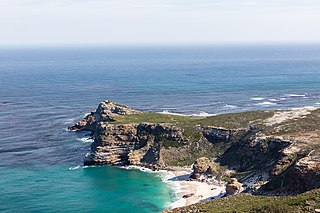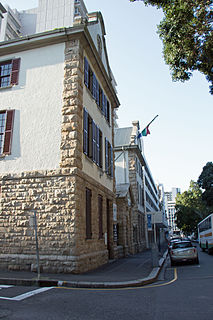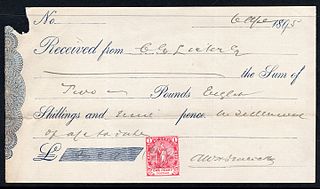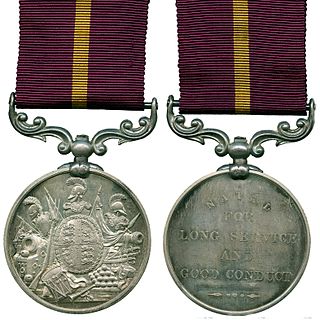Related Research Articles

The present coat of arms of South Africa was introduced on Freedom Day 27 April 2000 and designed by Mr Iaan Bekker. It replaced the earlier national arms, which had been in use since 1910. The motto is written in the Khoisan language of the ǀXam people and translates literally to "diverse people unite". The previous motto, in Latin, was Ex Unitate Vires, translated as "From unity, strength".

The Cape of Good Hope is a rocky headland on the Atlantic coast of the Cape Peninsula in South Africa.

The Cape Colony, also known as the Cape of Good Hope, was a British colony in present-day South Africa named after the Cape of Good Hope. The British colony was preceded by an earlier Corporate colony that became a Dutch colony of the same name, the Dutch Cape Colony, established in 1652 by the Dutch East India Company (VOC). The Cape was under VOC rule from 1652 to 1795 and under rule of the Napoleonic Batavia Republic from 1803 to 1806.

The coat of arms of the Cape Colony was the official heraldic symbol of the Cape Colony as a British colony from 1875 to 1910, and as a province of South Africa from 1910 to 1994.

John Henry de Villiers, 1st Baron de Villiers was a Cape lawyer and judge. He was Attorney-General in the Molteno Government, Chief Justice for the Cape Colony, and later the first Chief Justice for the Union of South Africa. As the country's most senior judge for 40 of its formative years, De Villiers is often considered the most influential judge in South African history.

The Cape of Good Hope General Service Medal is a British campaign medal which was awarded to members of the Cape Colonial Forces who took part in three campaigns in and around the Cape of Good Hope, in Basutoland in 1880–1881, in Transkei in 1880–1881 and in Bechuanaland in 1896–1897.

The Huguenot Memorial Building, located at 48 Queen Victoria Street, Cape Town, is a provincial heritage site in Cape Town in the Western Cape province of South Africa.

The Western Cape Division of the High Court of South Africa is a superior court of law with general jurisdiction over the Western Cape province of South Africa. The division, which sits at Cape Town, consists of 31 judges led by Judge President John Hlophe.
The Cape Medical Museum is situated in the Old City Hospital Complex in Green Point, Cape Town, South Africa. Its exhibitions center around the medical history of the Cape and includes exhibitions on dentistry, hospital care, traditional African medicine and pharmaceutical developments. It was founded by a group of volunteers in the 1980s led by Prof J C De Villiers. Since its conception it was proclaimed as a Provincial Museum of the government of the Western Cape province.
The following is a timeline of the history of Cape Town in the Western Cape province of South Africa.

The Union of South Africa Commemoration Medal is a military and civil commemorative medal which was awarded to commemorate the opening of the first Union Parliament by the Duke of Connaught and Strathearn in 1910. It may be considered as the first of many independence medals which were instituted throughout the Commonwealth during the 20th century.

Cape of Good Hope issued revenue stamps from 1864 to 1961. There were a number of different stamps for several taxes.
The Cape of Good Hope Government Gazette was the government gazette of Cape Colony.

In May 1895, Queen Victoria authorised Colonial governments to adopt various British military medals and to award them to their local military forces. The Cape of Good Hope introduced this system in September 1895 and, in 1896, instituted the Army Long Service and Good Conduct Medal .

In May 1895, Queen Victoria authorised Colonial governments to adopt various British military medals and to award them to their local military forces. The Colony of Natal introduced this system in August 1895 and, in 1897, instituted the Army Long Service and Good Conduct Medal (Natal).

In May 1895, Queen Victoria authorised Colonial governments to adopt various British military medals and to award them to members of their local permanent military forces. The Cape of Good Hope introduced this system in September 1895 and, in 1896, instituted the Meritorious Service Medal .

In May 1895, Queen Victoria authorised Colonial governments to adopt various British military medals and to award them to members of their local permanent military forces. The Colony of Natal introduced this system in August 1895 and, in 1897, instituted the Meritorious Service Medal (Natal).

In May 1895, Queen Victoria authorised Colonial governments to adopt various British military medals and to award them to their local permanent military forces. The Cape of Good Hope and Colony of Natal instituted their own territorial versions of the Meritorious Service Medal in terms of this authority. These two medals remained in use in the respective territories until after the establishment of the Union of South Africa in 1910.
The 1862 Birthday Honours were appointments by Queen Victoria to various orders and honours to reward and highlight good works by citizens of the British Empire. The appointments were made to celebrate the official birthday of the Queen, and were published in The London Gazette on 23 May and 25 July 1862.
The Cape Mounted Police was the principal law enforcement agency of the Cape Colony during its last three decades. In addition to its ordinary policing duties, it was a para-military organisation, which saw active service in several campaigns and operations, including the Anglo-Boer War (1899–1902). The force was fully militarised in 1913 and transferred to the new South African Army as a mounted rifle regiment.
References
- ↑ SOUTH AFRICA. CAPE PROVINCE (PROVINCE) CRL Foreign Official Gazette Database, 2014. Retrieved 14 May 2014. Archived here.